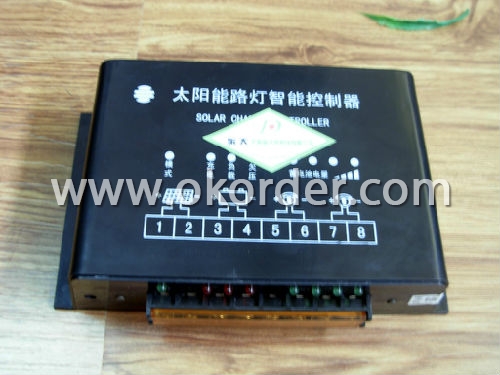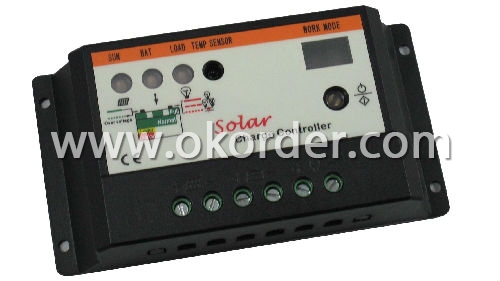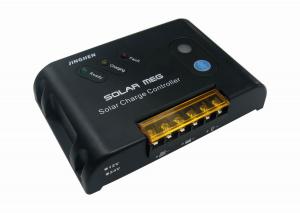L-Series PV Controller
- Loading Port:
- Nanjing
- Payment Terms:
- TT/LC
- Min Order Qty:
- 50sets set
- Supply Capability:
- 1-3000sets/month set/month
OKorder Service Pledge
OKorder Financial Service
You Might Also Like
Specification of L-Series PV Controller
Professional MCU microprocessor control, the real charge and discharge of intelligent control;
Low-loss, long-life MOSFET switching devices as the main controller;
PV charging(PWM) technology, a higher charging efficiency;
Operating status, fault LED indicates the;
Control modes: light control switch control mode / off light control to open when the control mode / automatic light control mode when the control;
Absorb the output circuit with inductive load;
Memory function, the controller re-energized after power on, automatically de-energized mode before;
Perfect protection;
Against reverse battery;
Maintenance easy, fast;
Optional Configuration of L-Series PV Controller:
RS485/RS232 Remote monitoring;
Supporting electricity can be a complementary manner to ensure uninterrupted power supply load;
Technical Data of L-Series PV Controller:
Voltage | 12V | 24V | 36V | 48V | ||
Rated current range | 5A~30A | 5A~30A | 5A~20A | 5A~20A | ||
Battery input | ||||||
Rated input voltage (VDC) | 12 | 24 | 36 | 48 | ||
Under voltage protection (VDC) | ≤10.8 | ≤21.6 | ≤32.4 | ≤43.2 | ||
Recovery voltage (VDC) | ≥12.3 | ≥24.6 | ≥36.9 | ≥49.2 | ||
Overvoltageprotection (VDC) | ≥16.5 | ≥33.0 | ≥49.5 | ≥66.0 | ||
Overvoltage recovery (VDC) | ≤15.0 | ≤30.0 | ≤45.0 | ≤60.0 | ||
Solar energy input | ||||||
Max. open circuit voltage (VDC) | 25.0 | 50.0 | 75.0 | 100.0 | ||
Light control open, turn off the lights | Voltage light(VDC) | ≤3.5 | ≤7.0 | ≤10.5 | ≤14.0 | |
Voltage light (VDC) | ≥7.0 | ≥14.0 | ≤21.0 | ≤28.0 | ||
Float voltage (VDC) | 13.7 | 27.4 | 41.1 | 54.8 | ||
Overcharge protection voltage (VDC) | ≥14.4 | ≥28.8 | ≥43.2 | ≥57.6 | ||
Charge recovery voltage (VDC) | ≤13.2 | ≤26.4 | ≤39.6 | ≤52.8 | ||
DC output | ||||||
Number of outputs(N) | 2 | |||||
Rated output current | load1 (A) | 2.5~15 | 2.5~15 | 2.5~10 | 2.5~10 | |
load2 (A) | 2.5~15 | 2.5~15 | 2.5~10 | 2.5~10 | ||
Overvoltage capacity | 120% overload 60 seconds off the output / 150% overload for 10 seconds to close the output | |||||
Control mode | Light control mode / time control mode / automatic control mode | |||||
Serial communication | RS485(A、B) | |||||
Mechanical dimensions, the work environment | ||||||
Size ( D x W x H ) | 230 x 145 x 75 | |||||
Reference weight (Kg) | 6 | |||||
Protection level | IP41 | |||||
Max. working altitude (m) | ≤3000 | |||||
Temperature range (℃) | -20 ~ +65 | |||||

L-Series PV Controller

L-Series PV Controller
Packaging & Delivery of L-Series PV Controller
Packaging: Wooden box or Customized
Delivery: Depends on the quantity or Customized
- Q:Can a solar controller be used with both 12V and 24V batteries?
- Yes, a solar controller can be used with both 12V and 24V batteries. Most modern solar controllers are designed to be compatible with various battery voltage systems, allowing users to connect both 12V and 24V batteries to the controller without any issues. However, it is important to ensure that the controller is capable of handling the higher voltage if using a 24V battery system.
- Q:Can a PWM solar controller be used with an MPPT solar panel?
- No, a PWM (Pulse Width Modulation) solar controller cannot be used with an MPPT (Maximum Power Point Tracking) solar panel. MPPT solar panels require an MPPT controller to optimize the power output and efficiency.
- Q:How do I calculate the size of a solar controller for my system?
- To calculate the size of a solar controller for your system, you need to consider two main factors: the maximum current capacity of your solar panels and the maximum current capacity of your battery bank. First, determine the maximum current output of your solar panels. This information is usually provided by the manufacturer. Next, determine the maximum current capacity of your battery bank. This can be calculated by dividing the battery capacity (in ampere-hours) by the desired charging time (in hours). Once you have these two values, choose a solar controller that can handle the higher of the two currents. It's recommended to choose a controller with a slightly higher current rating to allow for any future expansion of your solar panel or battery capacity.
- Q:Can a solar controller be used with solar-powered pool heating systems?
- Certainly! Solar-powered pool heating systems can definitely utilize a solar controller. In fact, a solar controller plays a vital role in these systems. Its main function is to regulate and manage the water flow within the solar panels, ensuring that the heating efficiency is at its best. By constantly monitoring the temperature of both the pool water and the solar collectors, the solar controller is able to make necessary adjustments to the flow rate and diverting valves, effectively directing the water through the solar collectors for optimal heating. Moreover, the solar controller can also provide valuable information regarding the system's performance and energy savings. This enables users to keep track of and optimize their pool heating system accordingly. Therefore, it is highly recommended to incorporate a solar controller into a solar-powered pool heating system in order to fully maximize the advantages of solar energy for pool heating.
- Q:What is the purpose of the battery overcharge protection feature on a solar controller?
- The battery overcharge protection feature on a solar controller serves to prevent damage to the batteries due to overcharging. When solar panels generate electricity from the sun, the excess energy is stored in batteries for future use. However, excessive charging beyond the batteries' capacity can result in overcharging, which poses several problems. Overcharging a battery can lead to overheating, causing degradation of its internal components and reducing its lifespan. It can also result in the release of hazardous gases, such as hydrogen, posing risks of explosions or fires. To mitigate these risks, solar controllers equipped with battery overcharge protection are designed to monitor the charging status of the batteries. Once the batteries reach their maximum capacity, the controller automatically detects this and interrupts the flow of electricity from the solar panels to the batteries, preventing further charging. This ensures that the batteries remain at an optimal charge level, promoting durability and safe operation. Moreover, the battery overcharge protection feature also optimizes the efficiency of the solar system. By preventing overcharging, the controller ensures that any excess energy generated by the solar panels is not wasted but can be used efficiently when needed. In conclusion, the battery overcharge protection feature on a solar controller aims to protect the batteries from potential damage caused by overcharging, prolong their lifespan, and enhance the overall efficiency of the solar system.
- Q:Solar controller red light flashing
- Solar controller flashing red light according to the different brands of the representative of the meaning of the controller are not the same, but in general terms, the red light flashing a saying that the battery is charging the battery is expressed as a red light flashing, green , The yellow light does not shine; another kind is the battery high pressure state or battery low voltage state that is red light flashing, green light does not light, hope to help you
- Q:What is the maximum load capacity of a solar controller?
- The maximum load capacity of a solar controller depends on its specifications and design. It can range from a few amps to several hundred amps, depending on the model and intended application.
- Q:Can a solar controller be used with solar panels that are connected to a solar cooling system?
- Yes, a solar controller can be used with solar panels that are connected to a solar cooling system. The solar controller regulates the flow of electricity from the solar panels to the cooling system, ensuring optimal performance and efficiency.
- Q:Can a solar controller be used with different types of inverters?
- Different types of inverters can be used with a solar controller. Also known as a charge controller, a solar controller regulates the charging process of a solar battery or battery bank by controlling the flow of current from the solar panels to the batteries. In contrast, an inverter converts the direct current (DC) electricity produced by the solar panels into alternating current (AC) electricity for powering household appliances and other electrical devices. The solar controller is typically connected between the solar panels and the batteries, whereas the inverter is connected to the batteries. The solar controller monitors the battery's state of charge and adjusts the charging current to prevent overcharging or undercharging. It does not have direct interaction with the inverter. Therefore, the compatibility between a solar controller and an inverter is not a concern since they have different purposes and operate independently. As long as the solar controller is compatible with the solar panel system and battery bank, it can be used with any type of inverter, including pure sine wave, modified sine wave, or grid-tie inverters.
- Q:Can a solar controller be used with a solar-powered marine system?
- Yes, a solar controller can be used with a solar-powered marine system. A solar controller regulates the charging and discharging of batteries connected to a solar panel system, ensuring optimal performance and preventing overcharging. This functionality is essential for maintaining and managing the power supply in a solar-powered marine system, making a solar controller a valuable component in such applications.
1. Manufacturer Overview |
|
|---|---|
| Location | Hefei,China |
| Year Established | 2004 |
| Annual Output Value | Above US$0.6 billion |
| Main Markets | Australia;Italy;Germany;U.K. England;Franch;NewZealand; |
| Company Certifications | Growatt5000;VDE0126;SAA;G83;TUV |
2. Manufacturer Certificates |
|
|---|---|
| a) Certification Name | |
| Range | |
| Reference | |
| Validity Period | |
3. Manufacturer Capability |
|
|---|---|
| a)Trade Capacity | |
| Nearest Port | Shenzhen |
| Export Percentage | 0.4 |
| No.of Employees in Trade Department | 10 People |
| Language Spoken: | English;Chinese;French;German |
| b)Factory Information | |
| Factory Size: | Above 15,000 square meters |
| No. of Production Lines | Above 5 |
| Contract Manufacturing | OEM Service Offered;Design Service Offered |
| Product Price Range | Average |
Send your message to us
L-Series PV Controller
- Loading Port:
- Nanjing
- Payment Terms:
- TT/LC
- Min Order Qty:
- 50sets set
- Supply Capability:
- 1-3000sets/month set/month
OKorder Service Pledge
OKorder Financial Service
Similar products
New products
Hot products
Hot Searches
Related keywords






























